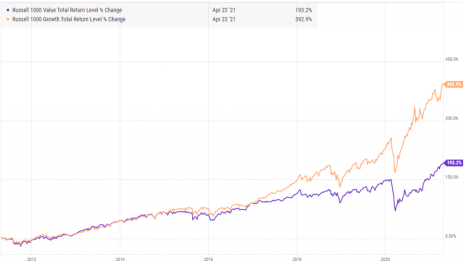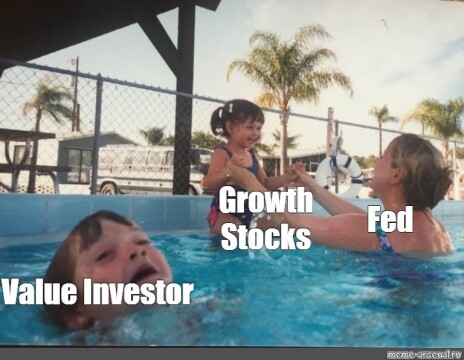Growth vs. value is an age-old market debate. But you can buy growth stocks at value prices. And the best way is through micro-cap stocks.
Are you a growth investor or a value investor?
The growth vs. value approach is a timeless debate and it will never be settled.
For the past 10 years, growth has absolutely clobbered value.
And I think many value investors can relate to the following meme.
But growth vs. value performance has always been cyclical.
Value stocks crushed growth stocks from 1999 to 2009, and growth stocks have crushed value stocks ever since.
While I do think that value stocks are poised for some solid returns over the next 10 years or so, I prefer to avoid an either-or approach.
Instead, I choose to invest in the best possible (usually growth) companies at value prices.
[text_ad]
This seems mutually exclusive, right?
If you are investing in the best possible companies, you are going to have to pay up.
Zoom (ZM), for example, grew revenue 369% last quarter. But you aren’t going to be able to buy Zoom at a “value” multiple. The stock trades at a P/E ratio of 146x.
So how do I find growth stocks at value prices? Micro-cap stocks.
The Advantage of Micro-Cap Stocks
What’s the catch? You have to be “poor” enough to invest in them.
Before Warren Buffett became famous for building Berkshire Hathaway into what it is today, he managed a small hedge fund with initial assets of $500,000.
Over the next 11 years, Buffett generated 31.6% annual returns (25.3% after fees) for his investors.
How did he do it? By investing in micro-caps.
Or take it from Peter Lynch, famed Fidelity portfolio manager who once wrote, “The size of a company has a great deal to do with what you can expect to get out of the stock. How big is this company in which you’ve taken an interest? Specific products aside, big companies don’t have big stock moves.”
Today, Buffett’s Berkshire Hathaway has $139 billion of cash on its balance sheet. Buffett goes “elephant hunting” to deploy that cash. In other words, he’s looking for large companies to buy.
He could invest in micro-caps, but it just wouldn’t move the needle for him.
But if you don’t have billions or even hundreds of millions, then odds are, it might make sense to invest a portion of your portfolio in micro-cap stocks.
Here are three examples of growth stocks trading at value multiples (disclosure: I own all three stocks) that are current recommendations in my Cabot Micro-Cap Insider advisory.
Before I share these ideas, I want to emphasize to use limits when buying micro-caps. If you don’t use a limit, a tiny order at the “market price” could move the market!
3 Micro-Cap Growth Stocks at Value Prices
Greystone Logistics (GLGI)
Greystone recycles plastic to manufacture pallets. The company has grown sales at a compound annual growth rate of 30.4% for the past four years yet trades at a value multiple with a P/E ratio of 8.9x. Sales have declined in the past calendar year due to the pandemic but should reaccelerate in 2021. Better yet, insiders own over 40% of company’s shares ensuring we are well aligned.
Medexus Pharma (MEDXF)
Medexus is a Canadian specialty pharma company that grew revenue by 94% the last quarter. It has a tremendous runway for growth as one of its products, treosulphan, is on the cusp of FDA approval and will provide the potential for the company to double its revenue. Despite rosy prospects, the company trades for just 1.4x revenue. Comparable companies trade at 2.5x to 3.0x revenue.
P10 Holdings (PIOE)
P10 is a private equity holding company. It has ownership stakes in a diversified portfolio of private equity management companies. Any time these private equity companies raise new funds, P10 adds to its revenue base. In 2020, P10 grew revenue 50%. P10 looks relatively expensive trading at 28x free cash flow, but if you adjust for several acquisitions that were completed in the last 12 months, the stock is trading at 12.4x free cash flow.
That’s what I call growth at a value price!
[author_ad]




